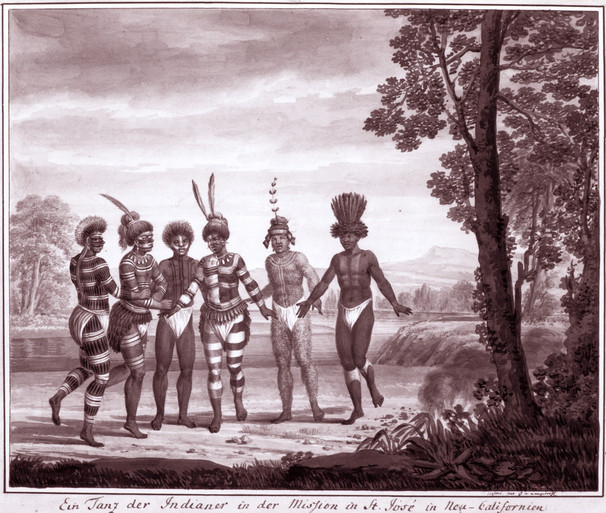 Muwekma Ohlone Indian Dancers at Mission Jose in Fremont, CA Rezanov / Langsdorff Expedition, circa 1806
Muwekma Ohlone Indian Dancers at Mission Jose in Fremont, CA Rezanov / Langsdorff Expedition, circa 1806
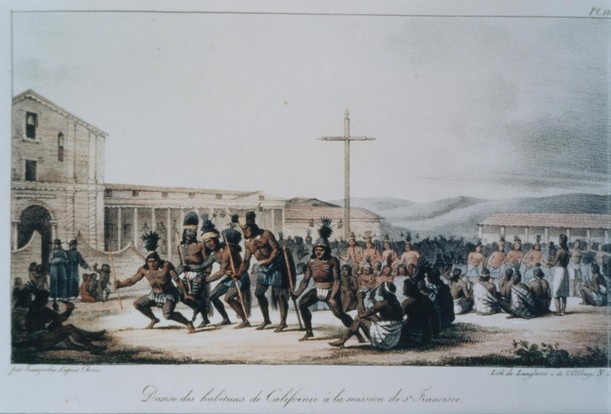 Muwekma Ohlone Indian Dancers at Mission Dolores in San Francisco, CA
by Russian Painter Louis Andrevitch Choris, circa 1816
Muwekma Ohlone Indian Dancers at Mission Dolores in San Francisco, CA
by Russian Painter Louis Andrevitch Choris, circa 1816
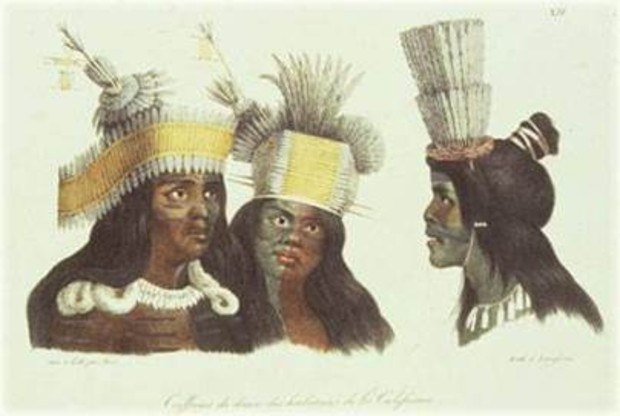 Muwekma Ohlone Indians at Mission Dolores in San Francisco, CA
by Russian Painter Louis Andrevitch Choris, circa 1816
Muwekma Ohlone Indians at Mission Dolores in San Francisco, CA
by Russian Painter Louis Andrevitch Choris, circa 1816
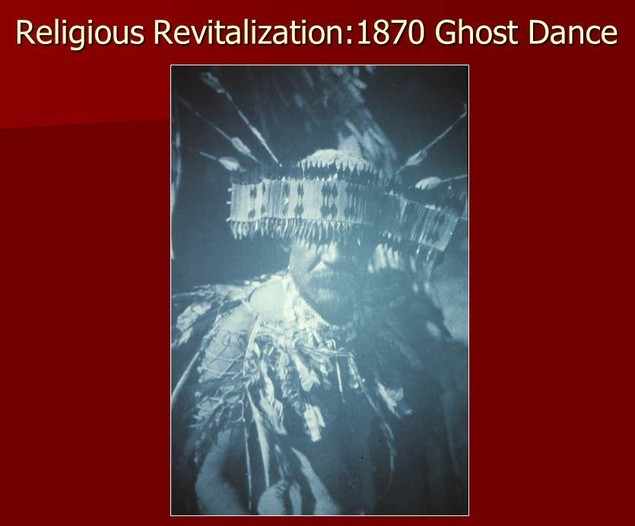 Religious Revitalization: 1870 Ghost Dance
Religious Revitalization: 1870 Ghost Dance
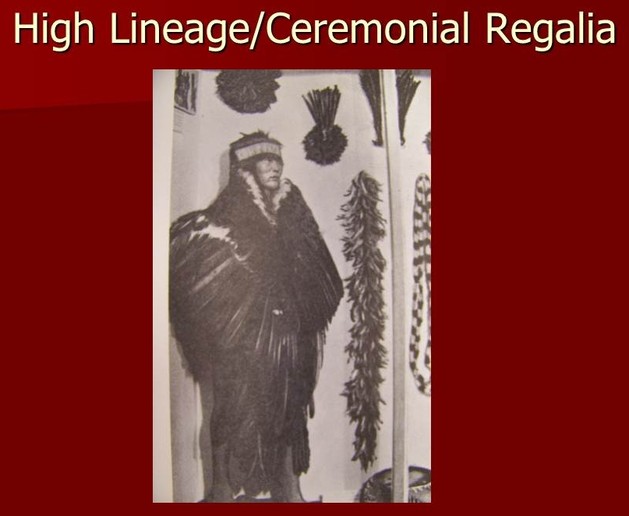 High Lineage/Ceremonial Regalia
High Lineage/Ceremonial Regalia
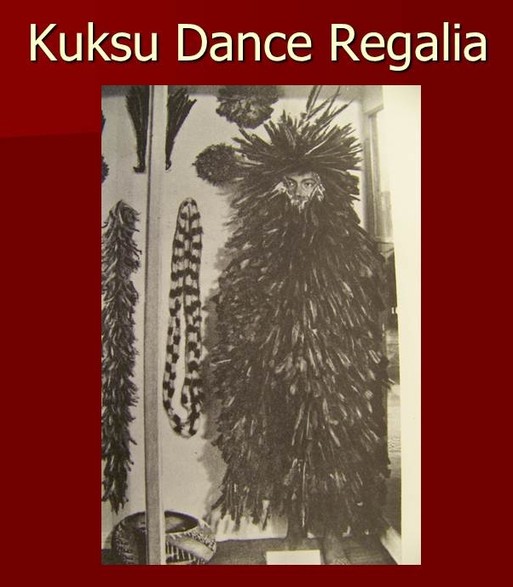 Kuksu Dance Regalia
Kuksu Dance Regalia
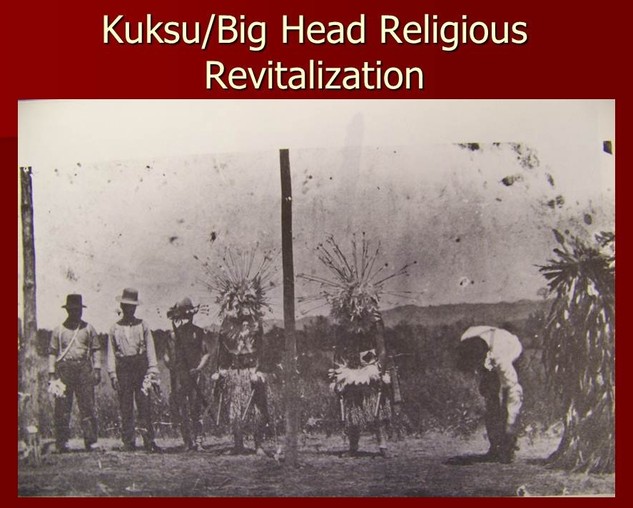 Kuksu/Big Head Religious Revitalization
Kuksu/Big Head Religious Revitalization
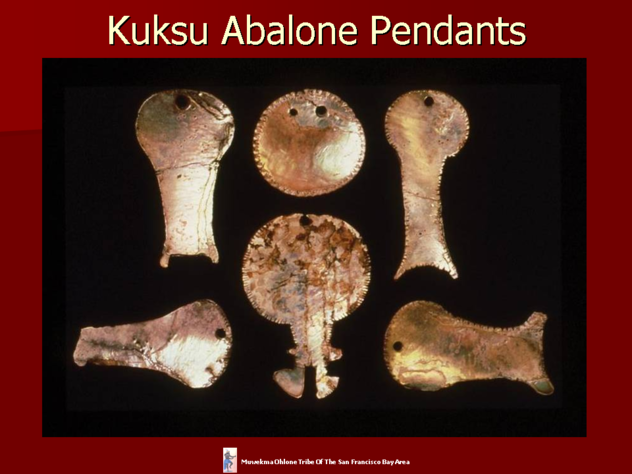 Kuksu Abalone Pendant Jewelry is Patterned after the Big Head Dancer
Kuksu Abalone Pendant Jewelry is Patterned after the Big Head Dancer
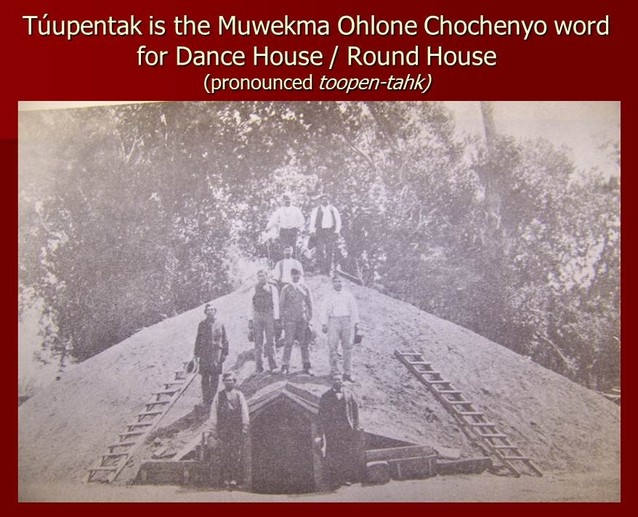 Túupentak is the Muwekma Ohlone Chochenyo word for Dance House / Round House (pronounced toopen-tahk)
Túupentak is the Muwekma Ohlone Chochenyo word for Dance House / Round House (pronounced toopen-tahk)
 Muwekma Ohlone Indians in a Tule Boat on the San Francisco Bay
by Russian Painter Louis Andrevitch Choris, circa 1822
Muwekma Ohlone Indians in a Tule Boat on the San Francisco Bay
by Russian Painter Louis Andrevitch Choris, circa 1822
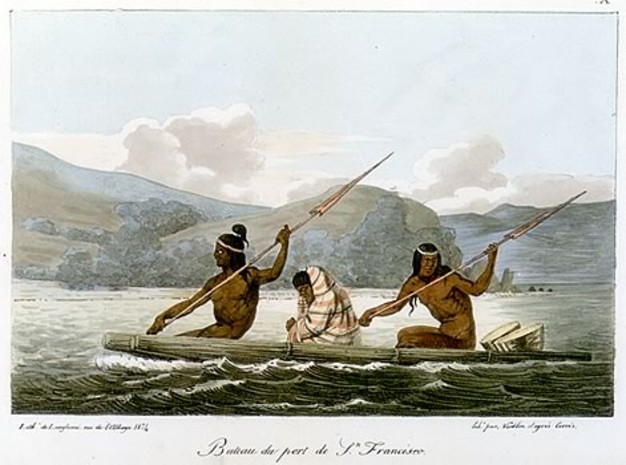 Muwekma Ohlone Indians Playing Games at Mission Dolores in San Francisco, CA
by Russian Painter Louis Andrevitch Choris, circa 1822
Muwekma Ohlone Indians Playing Games at Mission Dolores in San Francisco, CA
by Russian Painter Louis Andrevitch Choris, circa 1822
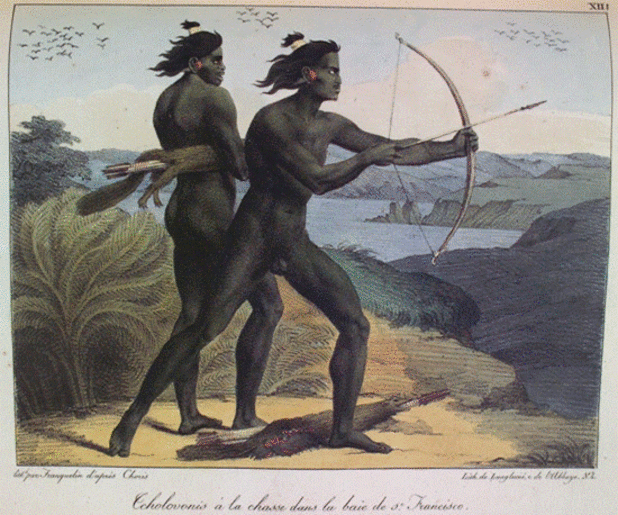 Muwekma Ohlone Indians, Cholvon Warriors Hunting Along the San Francisco Bay
by Russian Painter Louis Andrevitch Choris, circa 1822
Muwekma Ohlone Indians, Cholvon Warriors Hunting Along the San Francisco Bay
by Russian Painter Louis Andrevitch Choris, circa 1822
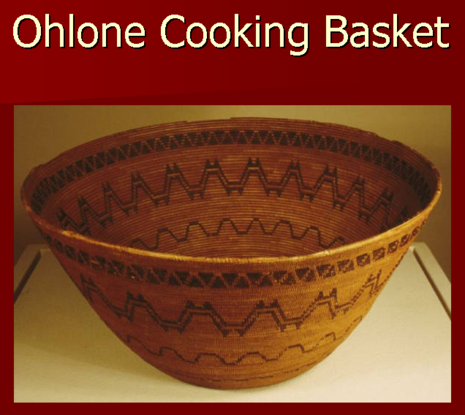 In the Muwekma Ohlone Chochenyo Language the word for basket is ’úuruš (pronounced ooroosh)
In the Muwekma Ohlone Chochenyo Language the word for basket is ’úuruš (pronounced ooroosh)
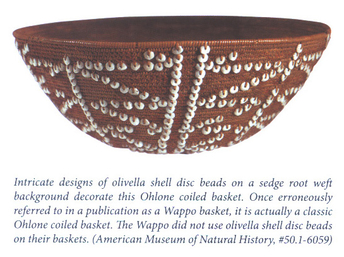 Intricate designs of olivella shell disc beads on a sedge root weft background decorate this Ohlone coiled basket. Once erroneously referred to in a publications as a Wappo basket, it is actually a classic Ohlone coiled bakset. The Wappo did not use olivella shell disc beads on their baskets. (American Museum of Naturl History, #50. 1-6059)
Intricate designs of olivella shell disc beads on a sedge root weft background decorate this Ohlone coiled basket. Once erroneously referred to in a publications as a Wappo basket, it is actually a classic Ohlone coiled bakset. The Wappo did not use olivella shell disc beads on their baskets. (American Museum of Naturl History, #50. 1-6059)
 Muwekma Ohlone Tribe Basket Weaving Classes
Muwekma Ohlone Tribe Basket Weaving Classes
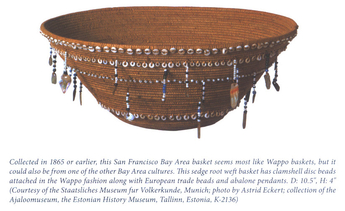 Collected in 1865 or earlier, this San Francisco Bay Area basket seems most like Wappo baskets, but it could also be from one of the other Bay Area cultures. This sedge root weft basket has clamsheel disc beads attached inthe Wappo fashion along with European trade beads and abalone pendants. D: 10.5", H:4" (Courtesy of the Staatsliches Museum fur Volkerkunde, Munich; photo by Astrid Eckert; collection of the Ajaloomuseum, the Estonian History Museum, Tallinn, Estonia, K-2136)
Collected in 1865 or earlier, this San Francisco Bay Area basket seems most like Wappo baskets, but it could also be from one of the other Bay Area cultures. This sedge root weft basket has clamsheel disc beads attached inthe Wappo fashion along with European trade beads and abalone pendants. D: 10.5", H:4" (Courtesy of the Staatsliches Museum fur Volkerkunde, Munich; photo by Astrid Eckert; collection of the Ajaloomuseum, the Estonian History Museum, Tallinn, Estonia, K-2136)
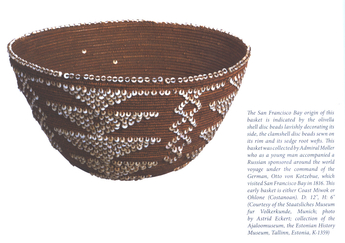 The San Francisco Bay origin of this basket is indicated by the olivella shell disc beads lavishly decorating its side, the clamshell disc beads sewn on its rim and its sedge root wefts. This basket was collected by Admiral Moller who as a young man accompanied a Russian sponsored around the world voyage under the command of the German, Otto von Kotzebue, which visited San Francisco Bay in 1816. This early basket is either Coast Mitwok or Ohlone (Costanoan) D: 12". H: 6" (Courtesy of the Staatsliches Museum fur Volkerkunde, Munich; photo by Astrid Eckert; collection fo the Ajaloomuseum, the Estonian History Museum, Tallian, Estonia, K-1359)/span>
The San Francisco Bay origin of this basket is indicated by the olivella shell disc beads lavishly decorating its side, the clamshell disc beads sewn on its rim and its sedge root wefts. This basket was collected by Admiral Moller who as a young man accompanied a Russian sponsored around the world voyage under the command of the German, Otto von Kotzebue, which visited San Francisco Bay in 1816. This early basket is either Coast Mitwok or Ohlone (Costanoan) D: 12". H: 6" (Courtesy of the Staatsliches Museum fur Volkerkunde, Munich; photo by Astrid Eckert; collection fo the Ajaloomuseum, the Estonian History Museum, Tallian, Estonia, K-1359)/span>
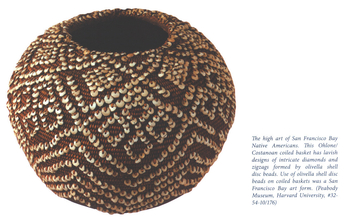 The high art of San Francisco Bay Native Americans. This Ohlone/Costanoan colied basket has lavish designs of intricate diamonds and zigzags formed by olivella shell disc beads. Use of olivella shell disc beads on colied baskets was a San Francisco Bay art form. (Peabody Museum, Harvard University, #32-54-10/176)
The high art of San Francisco Bay Native Americans. This Ohlone/Costanoan colied basket has lavish designs of intricate diamonds and zigzags formed by olivella shell disc beads. Use of olivella shell disc beads on colied baskets was a San Francisco Bay art form. (Peabody Museum, Harvard University, #32-54-10/176)
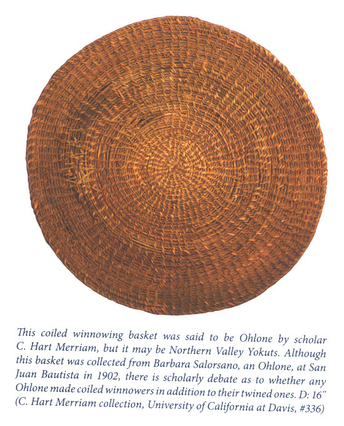 This colied winnowing basket was said to be Ohlone by scholar C. Hart Merriam, but it may be Northern Valley Yokuts. Althrough this basket was collected form Barbara Salorsano, an Ohlone, at San Juan Bautista in 1902, there is scholarly debate as to whether any Ohlone made colied winnowers in addition to their twined ones. D: 16" (C. Hart Merriam collection, Univesity of California at Davis, #336)
This colied winnowing basket was said to be Ohlone by scholar C. Hart Merriam, but it may be Northern Valley Yokuts. Althrough this basket was collected form Barbara Salorsano, an Ohlone, at San Juan Bautista in 1902, there is scholarly debate as to whether any Ohlone made colied winnowers in addition to their twined ones. D: 16" (C. Hart Merriam collection, Univesity of California at Davis, #336)
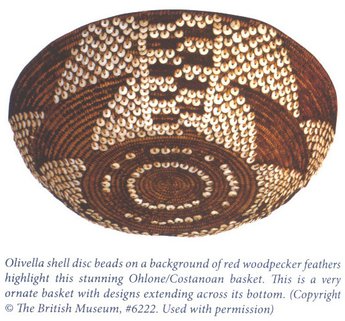 Olivella shell disc beads on a background of red woodpecker feathers highlights this stunning Ohlone/Costanon basket. This is a very ornate basket with designs extending across its bottom. (Copyright © The British Museum, #6222. Used with permission)
Olivella shell disc beads on a background of red woodpecker feathers highlights this stunning Ohlone/Costanon basket. This is a very ornate basket with designs extending across its bottom. (Copyright © The British Museum, #6222. Used with permission)
 Great art thrived among the California Indian people. This is an Ohlone/Costanoan colied basket from the San Francisco Bay Area. It is decorated with olivella shell disc beads and woodpecker feathers. California Native American baskets are a fine art that combines beauty, form and function. The San Franciso Bay and Monterey Bay areas are the home of the Ohlone people. (Musee de l'Homme, Paris, #09-19-53)
Great art thrived among the California Indian people. This is an Ohlone/Costanoan colied basket from the San Francisco Bay Area. It is decorated with olivella shell disc beads and woodpecker feathers. California Native American baskets are a fine art that combines beauty, form and function. The San Franciso Bay and Monterey Bay areas are the home of the Ohlone people. (Musee de l'Homme, Paris, #09-19-53)
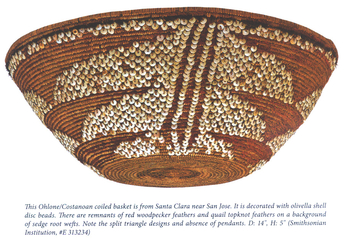 This Ohlone/Costanoan colied basket is from Santa Clara near San Jose. It is decorated with olivella shell disc beads. There are remnants of red woodpecker feathers and quail topknot fethers on a background of sedge root wefts. Note the split triangle designs and absence of pendants. DL 14", H: 5" (Smithsonian Institution, #E 313234)
This Ohlone/Costanoan colied basket is from Santa Clara near San Jose. It is decorated with olivella shell disc beads. There are remnants of red woodpecker feathers and quail topknot fethers on a background of sedge root wefts. Note the split triangle designs and absence of pendants. DL 14", H: 5" (Smithsonian Institution, #E 313234)
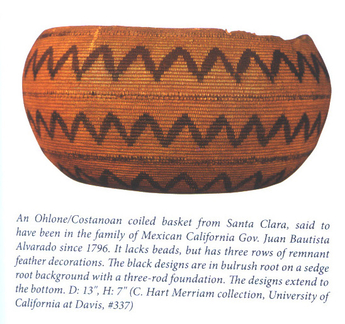 An Ohlone/Costanoan coiled basket from Santa Clara, said to have been in the family of Mexican California Gov. Juan Bautista Alvarado since 1796. It lacks beads, but has three rows of remnant feather decorations. The black designs are in bulrush root on a sedge root background with a three-rod foundation. The designs extend to the bottom. D: 13", H: 7" (C. Hart Merriam collection, Univesity of California at Davis, #337)
An Ohlone/Costanoan coiled basket from Santa Clara, said to have been in the family of Mexican California Gov. Juan Bautista Alvarado since 1796. It lacks beads, but has three rows of remnant feather decorations. The black designs are in bulrush root on a sedge root background with a three-rod foundation. The designs extend to the bottom. D: 13", H: 7" (C. Hart Merriam collection, Univesity of California at Davis, #337)
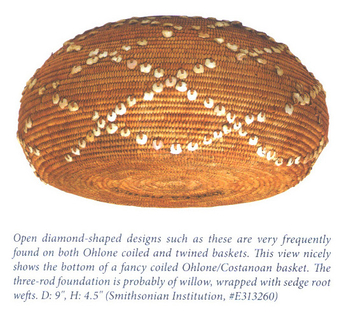 Open diamond shaped designs such as these are very frequently found on both Ohlone coiled and twined baskets. This view nicely shows the bottom of a fancy colied Ohlone/Costanoan basket. The three-rod foundation is probably of willow, wrapped with sedege root wefts. D:9", H: 4.5" (Smithsonian Institution, # E313260)an>
Open diamond shaped designs such as these are very frequently found on both Ohlone coiled and twined baskets. This view nicely shows the bottom of a fancy colied Ohlone/Costanoan basket. The three-rod foundation is probably of willow, wrapped with sedege root wefts. D:9", H: 4.5" (Smithsonian Institution, # E313260)an>
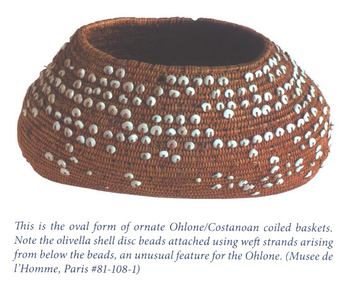 This is the oval form of ornate Ohlone/Costanoan Colied baksets. Note the olivella sheel disc beads attached using weft strands arising from below the beads, an unusual feature for the Ohlone. (Musee de l'Homme, Paris #81-108-1)
This is the oval form of ornate Ohlone/Costanoan Colied baksets. Note the olivella sheel disc beads attached using weft strands arising from below the beads, an unusual feature for the Ohlone. (Musee de l'Homme, Paris #81-108-1)
 Muwekma Ohlone Indian Dancers at Mission Jose in Fremont, CA Rezanov / Langsdorff Expedition, circa 1806
Muwekma Ohlone Indian Dancers at Mission Jose in Fremont, CA Rezanov / Langsdorff Expedition, circa 1806
 Muwekma Ohlone Indian Dancers at Mission Dolores in San Francisco, CA
by Russian Painter Louis Andrevitch Choris, circa 1816
Muwekma Ohlone Indian Dancers at Mission Dolores in San Francisco, CA
by Russian Painter Louis Andrevitch Choris, circa 1816
 Muwekma Ohlone Indians at Mission Dolores in San Francisco, CA
by Russian Painter Louis Andrevitch Choris, circa 1816
Muwekma Ohlone Indians at Mission Dolores in San Francisco, CA
by Russian Painter Louis Andrevitch Choris, circa 1816
 Túupentak is the Muwekma Ohlone Chochenyo word for Dance House / Round House (pronounced toopen-tahk)
Túupentak is the Muwekma Ohlone Chochenyo word for Dance House / Round House (pronounced toopen-tahk)
 Muwekma Ohlone Indians in a Tule Boat on the San Francisco Bay
by Russian Painter Louis Andrevitch Choris, circa 1822
Muwekma Ohlone Indians in a Tule Boat on the San Francisco Bay
by Russian Painter Louis Andrevitch Choris, circa 1822
 Muwekma Ohlone Indians Playing Games at Mission Dolores in San Francisco, CA
by Russian Painter Louis Andrevitch Choris, circa 1822
Muwekma Ohlone Indians Playing Games at Mission Dolores in San Francisco, CA
by Russian Painter Louis Andrevitch Choris, circa 1822
 Muwekma Ohlone Indians, Cholvon Warriors Hunting Along the San Francisco Bay
by Russian Painter Louis Andrevitch Choris, circa 1822
Muwekma Ohlone Indians, Cholvon Warriors Hunting Along the San Francisco Bay
by Russian Painter Louis Andrevitch Choris, circa 1822
 Intricate designs of olivella shell disc beads on a sedge root weft background decorate this Ohlone coiled basket. Once erroneously referred to in a publications as a Wappo basket, it is actually a classic Ohlone coiled bakset. The Wappo did not use olivella shell disc beads on their baskets. (American Museum of Naturl History, #50. 1-6059)
Intricate designs of olivella shell disc beads on a sedge root weft background decorate this Ohlone coiled basket. Once erroneously referred to in a publications as a Wappo basket, it is actually a classic Ohlone coiled bakset. The Wappo did not use olivella shell disc beads on their baskets. (American Museum of Naturl History, #50. 1-6059)
 Collected in 1865 or earlier, this San Francisco Bay Area basket seems most like Wappo baskets, but it could also be from one of the other Bay Area cultures. This sedge root weft basket has clamsheel disc beads attached inthe Wappo fashion along with European trade beads and abalone pendants. D: 10.5", H:4" (Courtesy of the Staatsliches Museum fur Volkerkunde, Munich; photo by Astrid Eckert; collection of the Ajaloomuseum, the Estonian History Museum, Tallinn, Estonia, K-2136)
Collected in 1865 or earlier, this San Francisco Bay Area basket seems most like Wappo baskets, but it could also be from one of the other Bay Area cultures. This sedge root weft basket has clamsheel disc beads attached inthe Wappo fashion along with European trade beads and abalone pendants. D: 10.5", H:4" (Courtesy of the Staatsliches Museum fur Volkerkunde, Munich; photo by Astrid Eckert; collection of the Ajaloomuseum, the Estonian History Museum, Tallinn, Estonia, K-2136)
 The San Francisco Bay origin of this basket is indicated by the olivella shell disc beads lavishly decorating its side, the clamshell disc beads sewn on its rim and its sedge root wefts. This basket was collected by Admiral Moller who as a young man accompanied a Russian sponsored around the world voyage under the command of the German, Otto von Kotzebue, which visited San Francisco Bay in 1816. This early basket is either Coast Mitwok or Ohlone (Costanoan) D: 12". H: 6" (Courtesy of the Staatsliches Museum fur Volkerkunde, Munich; photo by Astrid Eckert; collection fo the Ajaloomuseum, the Estonian History Museum, Tallian, Estonia, K-1359)/span>
The San Francisco Bay origin of this basket is indicated by the olivella shell disc beads lavishly decorating its side, the clamshell disc beads sewn on its rim and its sedge root wefts. This basket was collected by Admiral Moller who as a young man accompanied a Russian sponsored around the world voyage under the command of the German, Otto von Kotzebue, which visited San Francisco Bay in 1816. This early basket is either Coast Mitwok or Ohlone (Costanoan) D: 12". H: 6" (Courtesy of the Staatsliches Museum fur Volkerkunde, Munich; photo by Astrid Eckert; collection fo the Ajaloomuseum, the Estonian History Museum, Tallian, Estonia, K-1359)/span>
 The high art of San Francisco Bay Native Americans. This Ohlone/Costanoan colied basket has lavish designs of intricate diamonds and zigzags formed by olivella shell disc beads. Use of olivella shell disc beads on colied baskets was a San Francisco Bay art form. (Peabody Museum, Harvard University, #32-54-10/176)
The high art of San Francisco Bay Native Americans. This Ohlone/Costanoan colied basket has lavish designs of intricate diamonds and zigzags formed by olivella shell disc beads. Use of olivella shell disc beads on colied baskets was a San Francisco Bay art form. (Peabody Museum, Harvard University, #32-54-10/176)
 This colied winnowing basket was said to be Ohlone by scholar C. Hart Merriam, but it may be Northern Valley Yokuts. Althrough this basket was collected form Barbara Salorsano, an Ohlone, at San Juan Bautista in 1902, there is scholarly debate as to whether any Ohlone made colied winnowers in addition to their twined ones. D: 16" (C. Hart Merriam collection, Univesity of California at Davis, #336)
This colied winnowing basket was said to be Ohlone by scholar C. Hart Merriam, but it may be Northern Valley Yokuts. Althrough this basket was collected form Barbara Salorsano, an Ohlone, at San Juan Bautista in 1902, there is scholarly debate as to whether any Ohlone made colied winnowers in addition to their twined ones. D: 16" (C. Hart Merriam collection, Univesity of California at Davis, #336)
 Olivella shell disc beads on a background of red woodpecker feathers highlights this stunning Ohlone/Costanon basket. This is a very ornate basket with designs extending across its bottom. (Copyright © The British Museum, #6222. Used with permission)
Olivella shell disc beads on a background of red woodpecker feathers highlights this stunning Ohlone/Costanon basket. This is a very ornate basket with designs extending across its bottom. (Copyright © The British Museum, #6222. Used with permission)
 Great art thrived among the California Indian people. This is an Ohlone/Costanoan colied basket from the San Francisco Bay Area. It is decorated with olivella shell disc beads and woodpecker feathers. California Native American baskets are a fine art that combines beauty, form and function. The San Franciso Bay and Monterey Bay areas are the home of the Ohlone people. (Musee de l'Homme, Paris, #09-19-53)
Great art thrived among the California Indian people. This is an Ohlone/Costanoan colied basket from the San Francisco Bay Area. It is decorated with olivella shell disc beads and woodpecker feathers. California Native American baskets are a fine art that combines beauty, form and function. The San Franciso Bay and Monterey Bay areas are the home of the Ohlone people. (Musee de l'Homme, Paris, #09-19-53)
 This Ohlone/Costanoan colied basket is from Santa Clara near San Jose. It is decorated with olivella shell disc beads. There are remnants of red woodpecker feathers and quail topknot fethers on a background of sedge root wefts. Note the split triangle designs and absence of pendants. DL 14", H: 5" (Smithsonian Institution, #E 313234)
This Ohlone/Costanoan colied basket is from Santa Clara near San Jose. It is decorated with olivella shell disc beads. There are remnants of red woodpecker feathers and quail topknot fethers on a background of sedge root wefts. Note the split triangle designs and absence of pendants. DL 14", H: 5" (Smithsonian Institution, #E 313234)
 An Ohlone/Costanoan coiled basket from Santa Clara, said to have been in the family of Mexican California Gov. Juan Bautista Alvarado since 1796. It lacks beads, but has three rows of remnant feather decorations. The black designs are in bulrush root on a sedge root background with a three-rod foundation. The designs extend to the bottom. D: 13", H: 7" (C. Hart Merriam collection, Univesity of California at Davis, #337)
An Ohlone/Costanoan coiled basket from Santa Clara, said to have been in the family of Mexican California Gov. Juan Bautista Alvarado since 1796. It lacks beads, but has three rows of remnant feather decorations. The black designs are in bulrush root on a sedge root background with a three-rod foundation. The designs extend to the bottom. D: 13", H: 7" (C. Hart Merriam collection, Univesity of California at Davis, #337)
 Open diamond shaped designs such as these are very frequently found on both Ohlone coiled and twined baskets. This view nicely shows the bottom of a fancy colied Ohlone/Costanoan basket. The three-rod foundation is probably of willow, wrapped with sedege root wefts. D:9", H: 4.5" (Smithsonian Institution, # E313260)an>
Open diamond shaped designs such as these are very frequently found on both Ohlone coiled and twined baskets. This view nicely shows the bottom of a fancy colied Ohlone/Costanoan basket. The three-rod foundation is probably of willow, wrapped with sedege root wefts. D:9", H: 4.5" (Smithsonian Institution, # E313260)an>







